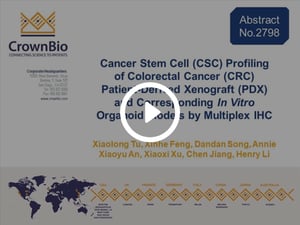AACR20 Poster 2798: Profiling the Cancer Stem Cell Components of PDX and PDX-Derived Organoids
Cancer Stem Cell (CSC) Profiling of Colorectal Cancer (CRC) Patient-Derived Xenograft (PDX) and Corresponding In Vitro Organoid Models by Multiplex IHC
Xiaolong Tu, Xinhe Feng, Dandan Song, Annie Xiaoyu An, Xiaoxi Xu, Chen Jiang, and Henry Li

Organoids are innovative in vitro 3D models, derived from stem cells from patient tissue. Using Hubrecht Organoid Technology (HUB) protocols, we’ve established a large biobank of PDX-derived organoids (PDXOs) generated using our wide range of PDX models as the initial tissue.
The PDX and derived PDXO constitute matched in vivo and in vitro model pairs, sharing similar genomic and pathology profiles, as well as pharmacological response to anticancer agents. These matched pairs provide a unique platform for transition from in vitro to in vivo studies.
This poster aimed to verify and characterize the cancer stem cell (CSC) components of both model types by multiplex IHC (mIHC), which is a vital signature to investigate biological equivalence between PDXs and PDXOs.
Watch this Poster to Discover:
- Preliminary data highlighting that most cells in PDX and PDXO models resemble the basal cell layer, where pan-CK+/CD44+ CSCs also co-localize, consistent with the hypothesis of both model types being CSC-driven disease models
- That the CRC CSC marker CD44 was observed broadly on the surface of tumor cells in both PDXO and PDX models
- How a second CSC marker, CD133 displayed a predominantly intraglandular-like staining pattern in PDXOs compared to non-significant periglandular-like staining in PDXs
Watch the Poster Now!



